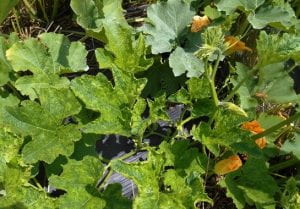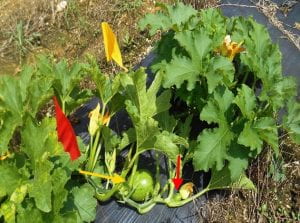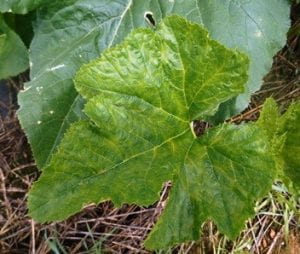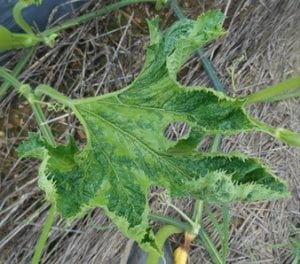Jerry Brust, IPM Vegetable Specialist, University of Maryland;jbrust@umd.edu
A number of pumpkin fields in Maryland have a great deal of virus infected plants (20-50%) while other pumpkin fields have none. Why the large differences in infection levels? This is something I have been looking at for the past two seasons. It has to do with what is around the pumpkin field and how long pumpkins and squash have been growing in the general area. I’ll have more on the results of this study at this year’s winter vegetable meetings. Almost all of the viruses found so far have been Watermelon mosaic virus-2 (WMV), with a small percentage being Zucchini yellow mosaic virus (ZYMV). The most common symptoms caused by these viruses are a leaf mosaic (variegated patterns of dark and light green to yellow that form a mosaic) and leaf distortion (Fig. 1). Symptoms may vary from plant to plant according to the species or varieties, viral concentration in the plant, timing of infection, single or mixed infection, or temperature. External symptoms may develop within four or five days after young plants become infected, but may take up to 14 days to develop when the foliage is older and more mature. Symptoms develop more rapidly at 80°-90°F than at 65°-75°F. Virus symptoms are more severe on plants exposed to short days or reduced light than on plants exposed to long days and bright light. Cucurbit plants rarely become infected in the seedling stage. When this does happen, the cotyledons may turn yellow and wilt. New leaves are slightly mottled a yellowish green and remain small, wrinkled, and distorted.
Typically, viruses affect pumpkin fruit by causing lumps, bumps and rings to appear on the skin of the fruit. However, at times there is little loss if the pumpkin fruit has been pollinated and begins to grow before virus infection occurs (Fig. 2). Figure 2 shows a pumpkin plant with a new WMV infection, the larger pumpkin fruit will develop normally, but the smaller fruit just pollinated will not develop at all and will be aborted by the plant. Infection just after pollination may cause the pumpkin fruit to have blotches or stripes of green or yellow color. If the plant is infected before pollination there usually is no fruit production, but if some are produced then symptoms on the fruit include surface discoloration, bumps and other fruit deformity, early browning, shrinking or death, small fruit size and poor yields. Secondary infection by other microorganisms may occur on the virus infected fruits and cause soft rot.
Figure 1. Pumpkin plant infected with WMV
Figure 2. Larger pumpkin fruit (yellow arrow) will develop normally while smaller fruit will not (red arrow)
On pumpkin plants, viruses can either infect the plant alone or together. If a plant is infected by only one virus, the symptoms generally are milder (Fig. 3) than if by two or more (Fig. 4). Infection by two viruses initially causes a strong mosaic and distortion of leaves. Infected plants have smaller and smaller new leaves. Late stage infections consist of leaves that turn yellow or become scorched along the edge.
Figure 3. Pumpkin plant infected with one virus
Figure 4. Pumpkin plant infected with 2 viruses
Aphids transmit viruses to plants through their sucking mouthparts. Viruses that are non-persistently transmitted, as are most pumpkin viruses, are difficult to manage because the aphids acquire and transmit the viruses so quickly. The acquisition or transmission of non-persistently transmitted (NPT) viruses is completed in a matter of seconds or minutes. NPT viruses cannot spread very far from where they were originally acquired by the aphid. Pesticides sprayed on the plant will eventually kill the aphids, but too late to stop them from transmitting the virus. Therefore, insecticides have little effect on initial infection rates of NPT viruses transmitted by transient, non-colonizing aphids (these are aphids that are passing through the field, land on and taste the pumpkin plant, do not like it and move on, but they have transmitted the virus). Insecticides can control aphid honeydew production and secondary spread of viruses in the field.




